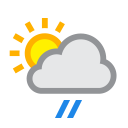Current Weather in Eldoret
 Patchy rain possible
Patchy rain possible15.9°C60.6°F
- Current Temperature: 15.9°C60.6°F
- Current Feels‑Like Temperature: 15.9°C60.6°F
- Current Humidity: 76%
- Minimum Temperature/Maximum Temperature: 11.9°C53.4°F / 21.5°C70.6°F
- Wind Speed: 2.9km/h
- Wind Direction: ↑ From the North-Northwest
(Data Time 01:00 / Data Retrieved 2025-08-27 22:00)
Climate‑Related Culture in Eldoret
Cultural and meteorological awareness regarding Kenya's climate is closely linked to the diverse natural environment and lifestyle culture. Below are the main characteristics.
Diversity of Climate and Lifestyle
Regional Climate Zone Awareness
- The perception that the felt temperature and precipitation patterns vary significantly depending on the region, such as the tropical rainforest climate directly under the equator, the temperate climate of the Kenyan highlands, and the semi-arid/arid climate in the north, is a common part of daily consciousness.
- The structure of houses and the materials of clothing (lightweight attire emphasizing breathability, warm clothing for nighttime, etc.) are selected and utilized according to the climatic characteristics of the residential area.
Traditional Events and Seasonal Sensibility
Mombasa Rain Prayers Festival (Malindi Mita)
- On the Indian Ocean coast, traditional rain prayers are conducted before the long rains, enhancing the farming expectations and community cohesion.
- Through dances and recitations of poetry, the festival transmits past meteorological experiences to the next generation.
Nairobi Highlands New Year Harvest Festival
- In mountainous areas and highland villages, the harvesting of staple crops (such as maize and sorghum) is celebrated, expressing gratitude for abundant harvests and stable weather.
- There is a custom among residents to share the harvest and exchange weather forecasts for the upcoming season.
Agricultural Practices and Weather Knowledge
Understanding Rainy and Dry Seasons and Planting/HARVEST Planning
- In Kenya, the long rainy season (April to June) and short rainy season (October to December) form the basis of the agricultural calendar, strictly managing the timing of planting, fertilization, and harvesting.
- Traditional "village meteorologists (rain masters)" observe weather signs and provide advice on shifts in rainfall timing and intensity.
Soil Moisture Observation and Simple Meteorological Instruments
- Comprehensive assessments of well water levels, river flow, and cloud shapes allow for fine-tuning of planting timing.
- In some regions, simple rain gauges (using bamboo tubes or plastic bottles) are homemade, and there is a habit of sharing information within the community.
Weather Forecasting and Information Transmission
Traditional Information Networks and Radio & Mobile
- Judgments are made by combining oral traditions from village elders and rural meteorologists with national radio broadcast weather news.
- The usage rate of mobile phone SMS weather information services and smartphone applications is rapidly increasing, permeating both urban and rural areas.
Community Weather Education
- Weather sensing workshops conducted by NGOs and schools educate on how to interpret weather data and respond to disasters.
- In areas at high risk for disasters, early warning systems based on weather information (such as VHF radio broadcasts) are also being established.
Awareness of Climate Change Response
Drought and Flood Countermeasures and Regional Collaboration
- Experiencing increased drought frequency and intensified localized heavy rains over the past few decades has heightened interest in water resource management and disaster response training.
- Local water user cooperatives lead well-drilling and water conservation projects, preparing the community for weather variations.
Sustainable Agriculture and Weather Adaptation
- The promotion of climate-resilient agricultural techniques such as dryland farming, agroforestry, and the introduction of drought-resistant crops is underway.
- Efforts are expanding in weather-risk-prone areas, receiving subsidies and technical support from government agencies and international organizations.
Summary
| Element | Example Content |
|---|---|
| Regional Awareness | Housing and clothing choices based on climate zones, adjustments in lifestyle rhythm |
| Traditional Events | Rain prayers, harvest festivals, and rituals celebrating seasonal changes |
| Agricultural Weather Knowledge | Observation of rainy/dry seasons, planting/harvesting planning, use of simple meteorological instruments |
| Information Transmission | Elder traditions plus radio/SMS/apps, weather education programs |
| Climate Change Response | Drought and flood countermeasures, sustainable agriculture, community disaster preparedness activities |
Kenya's weather culture combines a deep understanding of the natural environment, traditional knowledge, and modern technology to support the safety and prosperity of local communities.